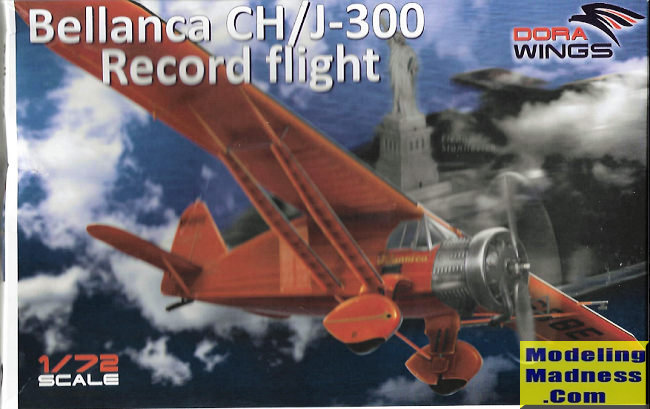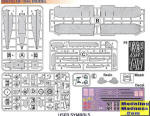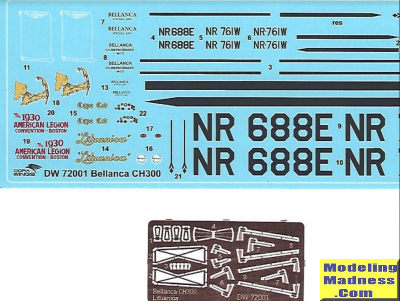
| KIT #: | 72001 |
| PRICE: | $25.50 |
| DECALS: | Three options |
| REVIEWER: | John Summerford |
| NOTES: | No color information |

| HISTORY |
The Bellanca CH-300 Pacemaker was a six-seat utility aircraft, built primarily in the United States in the 1920s and 1930s. It was a conventional, high-wing braced monoplane with fixed tailwheel undercarriage. Like other Bellanca aircraft of the period, it featured "flying struts" and were powered by 300 hp Wright J-6s.
One of the first records set by a Bellanca CH-300 series aircraft occurred on July 28Ė30, 1931, when Russell Norton Boardman (age 33) and John Louis Polando (age 29) flew from Floyd Bennett Field to Istanbul, Turkey in a Bellanca "Special J-300" high-wing monoplane named Cape Cod, registration NR761W. They made it safely to Istanbul nonstop in 49:20 hours, establishing a distance record of 5,011.8 miles (8,065.7 km), the first nonstop record flight in surpassing 5,000 miles.
On June 3, 1932, Stanislaus F. Hausner, flying a Bellanca CH Pacemaker named Rose Marie, powered by a 300-hp Wright J-6, attempted a transatlantic flight from Floyd Bennett Field, New York, to Warsaw, Poland. The attempt failed when he made a forced landing at sea; he was rescued by a British tanker eight days later.
On July 15, 1933 6:24 AM two Lithuanian pilots Steponas Darius ir Stasys Girėnas flying a heavily modified CH-300 lifted off from Floyd Bennet Field to attempt a nonstop transatlantic flight. They successfully crossed the Atlantic, however crashed in the forest near Pszczelnik, Poland.
| THE KIT |
 Enclosed
in a zip-top bag are four gray plastic sprues, one sprue of clear parts plus
their masks, two resin spats, a fret of photo etch, (in its own bag) and set of
three decal markings. (Also in its own bag.) Two of the markings are for the
successful trans-Atlantic crossings and the third for a Boston based aircraft.
Total plastic parts count is 57. Some of the parts are very small and removing
them from the sprue gates will be a challenge.
Enclosed
in a zip-top bag are four gray plastic sprues, one sprue of clear parts plus
their masks, two resin spats, a fret of photo etch, (in its own bag) and set of
three decal markings. (Also in its own bag.) Two of the markings are for the
successful trans-Atlantic crossings and the third for a Boston based aircraft.
Total plastic parts count is 57. Some of the parts are very small and removing
them from the sprue gates will be a challenge.
 Rib and
fuel tank detail on the wings look like they could be sanded down a bit. Cockpit
detail is basic and the cabin detail is nonexistent. Iím sure extra fuel tanks
were installed there for the long-distance flights. If you wish to model a
passenger plane, youíll have scratch build windows and seats and source the
livery. It might be interesting to render a bush plane on floats such as the one
on display at the Canada Aviation Museum.
Rib and
fuel tank detail on the wings look like they could be sanded down a bit. Cockpit
detail is basic and the cabin detail is nonexistent. Iím sure extra fuel tanks
were installed there for the long-distance flights. If you wish to model a
passenger plane, youíll have scratch build windows and seats and source the
livery. It might be interesting to render a bush plane on floats such as the one
on display at the Canada Aviation Museum.
The instructions extend over four sheets through 20 steps. An introduction, parts map and three pages of painting and decaling diagrams make for half of the packet and assembly diagrams make up the rest. There are no color call-outs.
| CONCLUSIONS |
Iím not a fan of 72nd scale models but I am delighted to see more obscure subjects--especially civilian--done as injected molded kits. I donít see anything tricky, so this kit should prove to be an entertaining build.
| REFERENCES |
https://en.wikipedia.org/wiki/Bellanca_CH-300_Pacemaker
July 2019
Copyright ModelingMadness.com
If you would like your product reviewed fairly and fairly quickly, please contact the editor or see other details in the Note to Contributors.
Back to the Main Page Back to the Review Index Page Back to the Previews Index Page